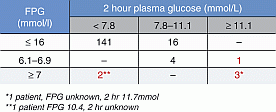ECE2013 Poster Presentations Diabetes (151 abstracts)
Reconsidering guidance for postnatal glucose screening in gestational diabetes
Sheba Jarvis 1, , Christine Feben 2 , Stephanie Roy 2 , Richard Sheridan 2 , Tony Boret 2 , Orla Trainor 2 & Michael R Clements 2
1Imperial College London, Hammersmith Hospital, London, UK; 2Watford General Hospital, Vicarage Road, Watford, UK.
Background: National Institute for Health and Clinical Excellence (NICE) guidelines advise that GDM be diagnosed using a 2-hr 75 g oral glucose tolerance test (OGTT). However there is lack of consensus on the optimal postpartum surveillance. Current postpartum screening guidance suggests a single fasting plasma glucose (FPG) at 6-weeks with annual testing thereafter. As women with GDM are often from mixed ethnic groups and frequently have postprandial hyperglycaemia, a 2-h OGTT result may be more relevant.
Objectives: Our study assessed if postpartum screening using FPG alone missed significant numbers of patients with pre-diabetes or impaired glucose tolerance (IGT).
Methods: Retrospective analysis of 211 women diagnosed with GDM over a 4-year period was undertaken. All pregnant women had a plasma glucose screen at booking and 28 weeks. OGTT was undertaken if FPG was >6.0 mmol/l or random plasma glucose was ≥7 mmol/l, and also in the presence of glycosuria or major clinical risk factors. All patients were invited for a postnatal OGTT at 6-weeks postpartum.
Results: 12 788 mothers were subject to plasma glucose screening in pregnancy. GDM was diagnosed on OGTT if FPG was >6.0 mmol/l or 2-h value was ≥7.8 mmol/l and the incidence was 1.65%. In 33 women a FPG >6.0 mmol/l was observed (7.62±0.76 mmol/l, mean±S.E.M.) and all patients had elevated 2-h values ≥7.8 mmol/l (9.79±0.01). 79% of women attended for postnatal OGTT. 6 women had frank diabetes and 12% had impaired glucose tolerance (2-h value 9.30±0.06 mmol/l) which would have been missed on FPG alone.

Conclusion: GDM was diagnosed most commonly on elevated 2-h glucose rather than FPG. Using FPG alone for postnatal screening misses a substantial number of cases of women with persisting IGT. As post-prandial hyperglycaemia is associated with increased cardiovascular risk, lifestyle advice and closer surveillance is required.
 }
}



